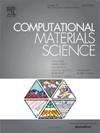Thermally induced evolution in non-hydrogenated and hydrogenated amorphous carbon films: A molecular dynamics research
IF 3.1
3区 材料科学
Q2 MATERIALS SCIENCE, MULTIDISCIPLINARY
引用次数: 0
Abstract
Amorphous carbons have received significant attention due to their excellent tribological properties. In this paper, molecular dynamics (MD) simulations were performed to study the thermally induced structural evolutions and hybridization transitions in non-hydrogenated (a-C) and hydrogenated (a-C:H) amorphous carbon films. The results indicated that the amorphous carbon gradually transforms into a graphitic carbon network under thermal effect. The hybridization transition is characterized by a three-stage process: (i) elongation of the existing bonds, (ii) breakage of one existing bond or formation of one bond, and (iii) relaxation. For low-density a-C film, the formation of void defects can be observed within high-temperature regions. With increasing densities, the diffusivity of a-C films decreases significantly, indicative of better thermal stability. Also, a glass-transition process can be observed in a-C films at around 3200 K, showing no obvious correlation with film densities. For a-C:H films, the incorporation of low-mass hydrogen atoms induces a highly diffusive amorphous network, which would deteriorate the thermal stability. With increasing hydrogen contents, both glass-transition temperatures and activation energies decrease. Also, as shown by the lower potential barriers and bond stretching distances, hybridization transitions are prone to occur in a-C:H films with high hydrogen contents.

求助全文
约1分钟内获得全文
求助全文
来源期刊

Computational Materials Science
工程技术-材料科学:综合
CiteScore
6.50
自引率
6.10%
发文量
665
审稿时长
26 days
期刊介绍:
The goal of Computational Materials Science is to report on results that provide new or unique insights into, or significantly expand our understanding of, the properties of materials or phenomena associated with their design, synthesis, processing, characterization, and utilization. To be relevant to the journal, the results should be applied or applicable to specific material systems that are discussed within the submission.
 求助内容:
求助内容: 应助结果提醒方式:
应助结果提醒方式:


